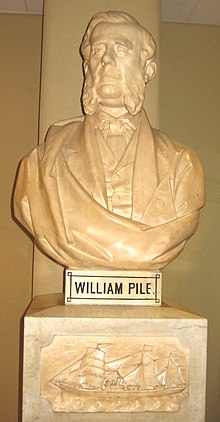William Pile, Hay and Co.
| William Pile | |
|---|---|

Designer, shipwright and engine builder
|
|
| Born |
10 October 1822 Sunderland, England |
| Died |
5 June 1873 (aged 50) Hotel, Bishipgate Street, London, England |
| Nationality | English |
| Citizenship | British |
William Pile (10 October 1822 – 5 June 1873) was a British shipbuilder. He was the first to introduce the Clipper class of ship to the river Wear, Sunderland. A testament to his art can be seen today, the Composite Clipper ship City of Adelaide. The ship was classed as "Experimental" by Lloyd's of London in 1864; it would be a few years before Lloyds would formalise the rules for constructing composite ships, the rules for which were used for the design and construction of the composite Clipper ship Cutty Sark.
His bust, now on display in the Sunderland Museum and Winter Gardens, was paid for by donations from his friends.
William Pile was born at the White House, Low Southwick, Sunderland, son of William Pile and brother to John. The house was surrounded by the shipyard of J. Mills, for whom his grandfather, another William Pile, was superintending the construction of wooden ships.
Pile's ancestors, who were farmers, had arrived in Sunderland around 1770 from Rothbury, Northumberland. His grandfather was the first shipbuilder of the family, being so adept that he was made manager of a shipyard shortly after completing his apprenticeship. Preferring to manage rather than build on his own account, his ships were considered to be well-built and fast. He passed on his good knowledge of both the theory and practice of shipbuilding to many of people who subsequently built on the Wear, including William. Pile's father was also noted for his well-modelled ships and considered the first shipbuilder of his day.
At a very early age, Pile took great interest in everything connected with ships and could not be kept out of the shipyard. In 1823 he moved to Monkwearmouth. He began constructing little ships with paper sails from the age of five and from these he advanced to little yachts with cotton sails which he sailed in local ponds and streams. When asked by a friend, as to the shape of his yachts, he replied "Cod's head and mackerel tail", a shape favoured by British boat designers from as far back as the 18th century.
...
Wikipedia
